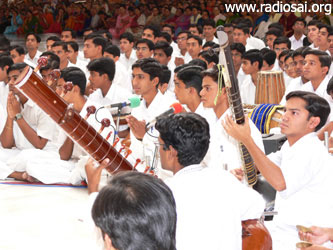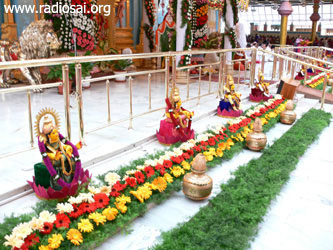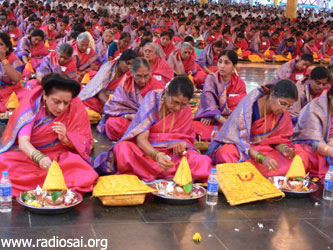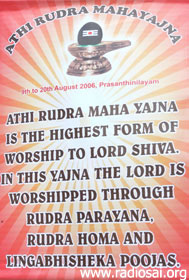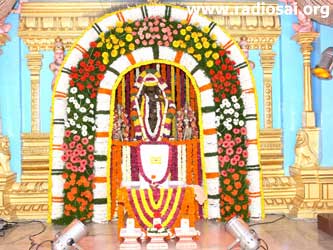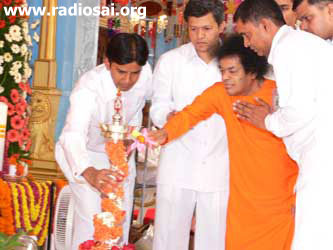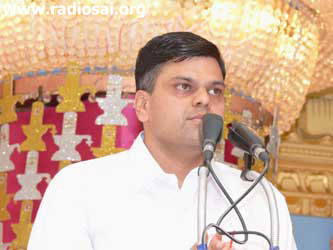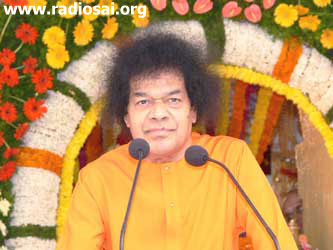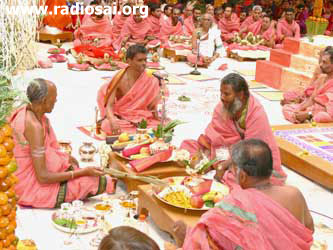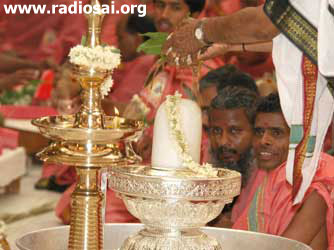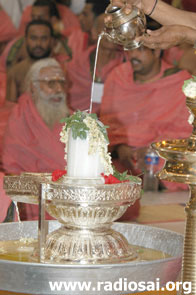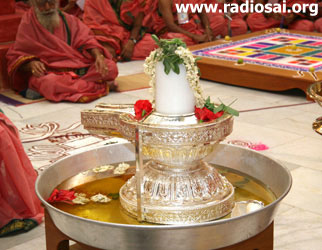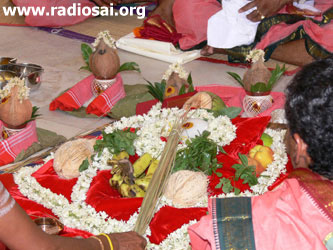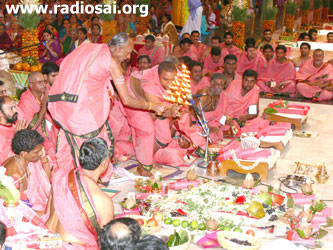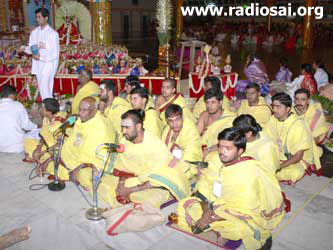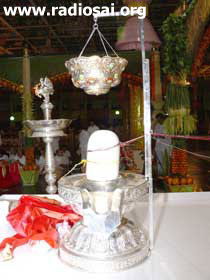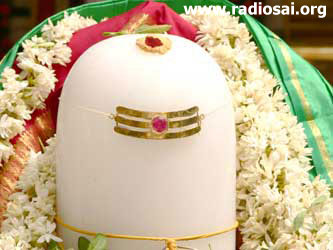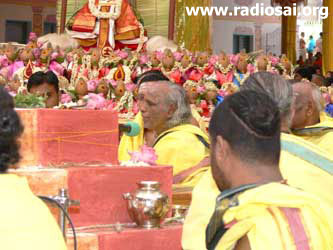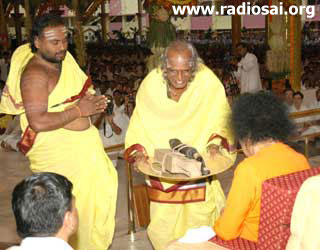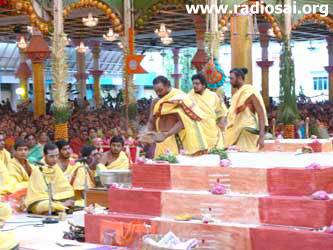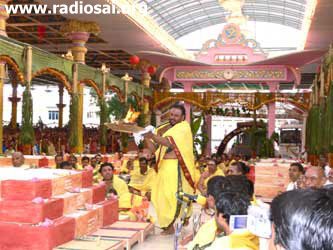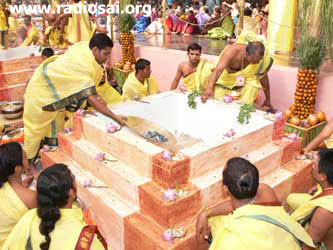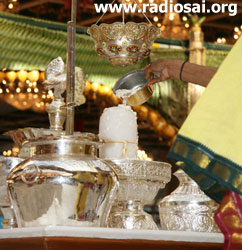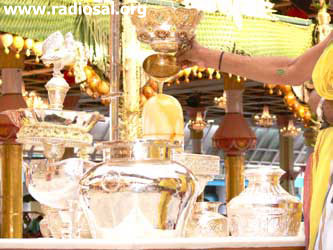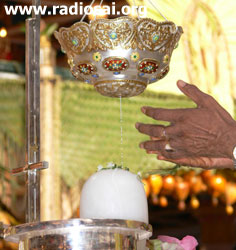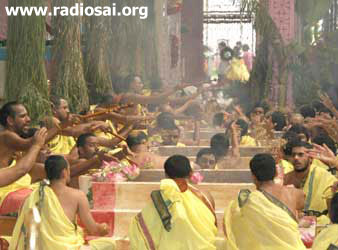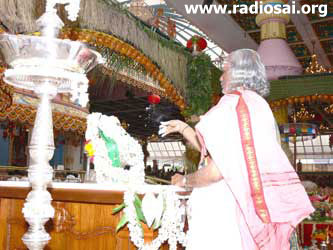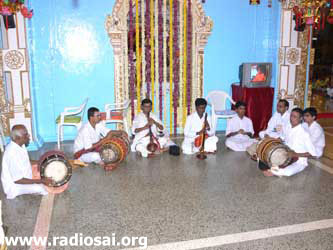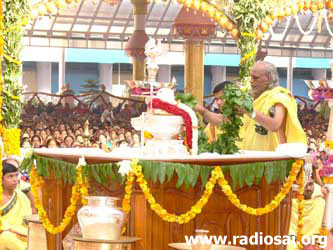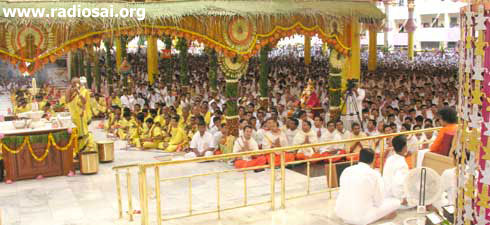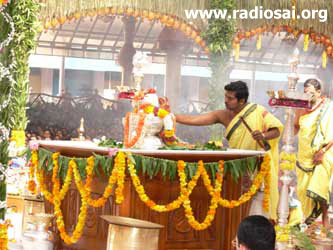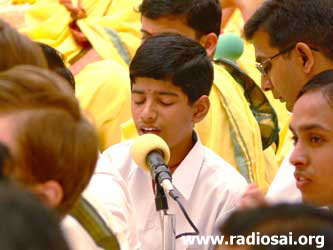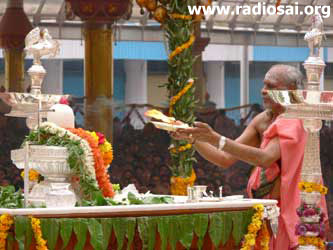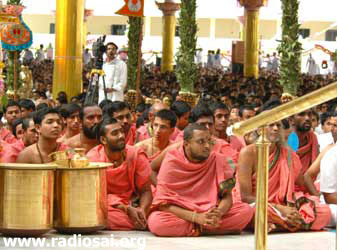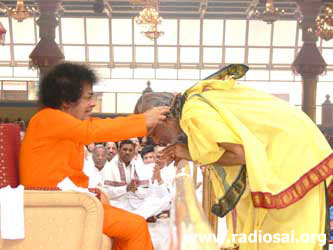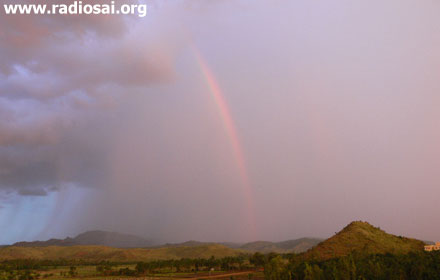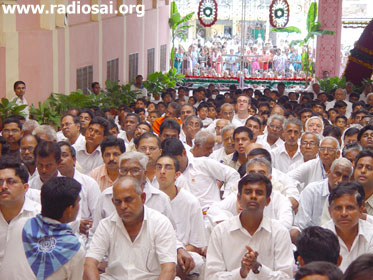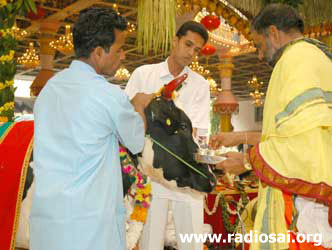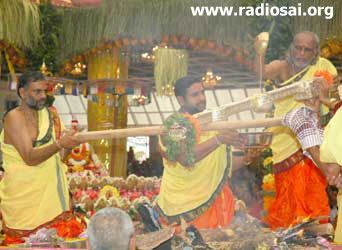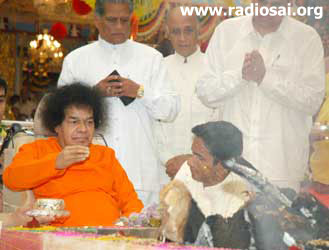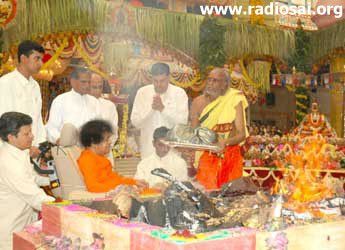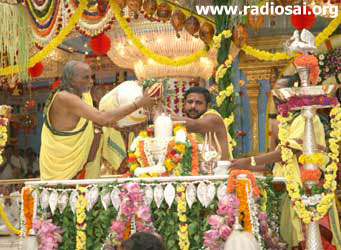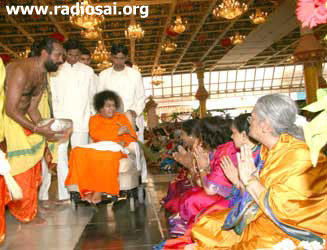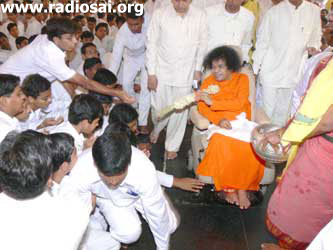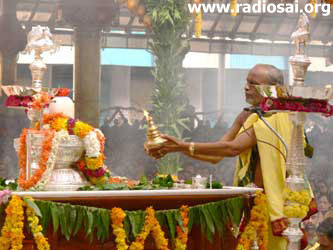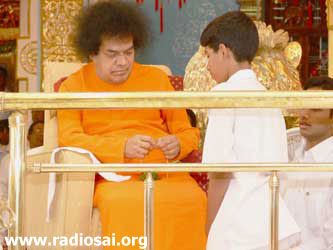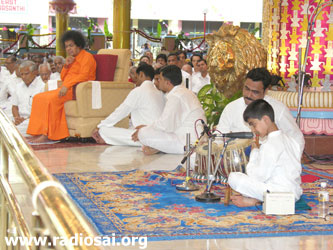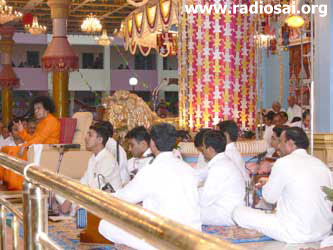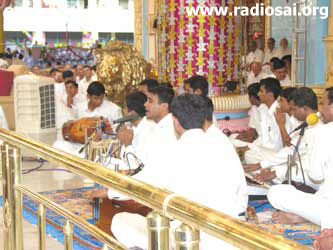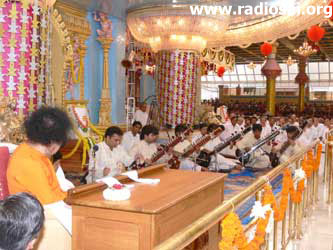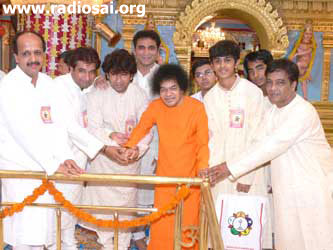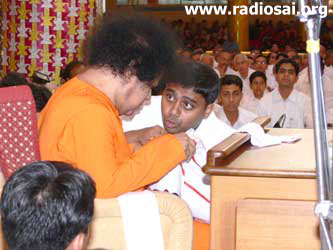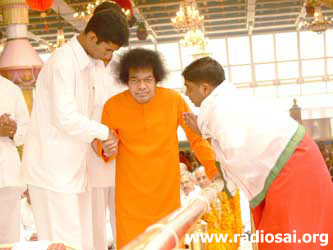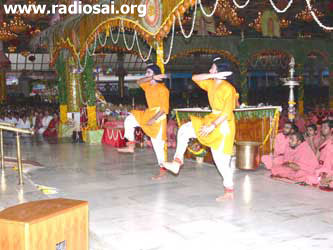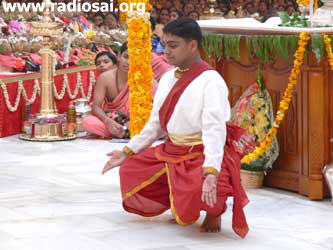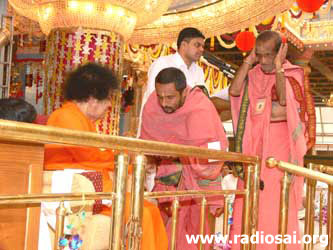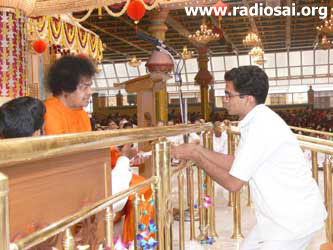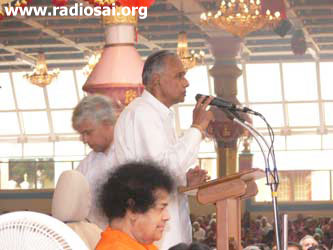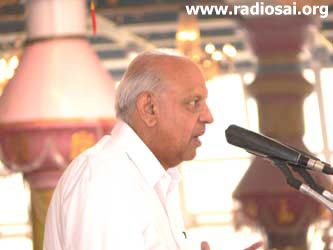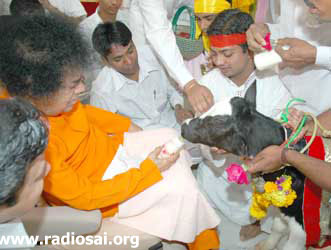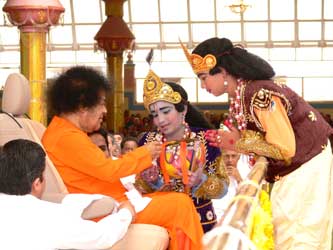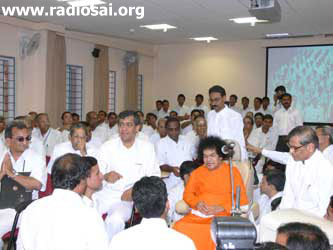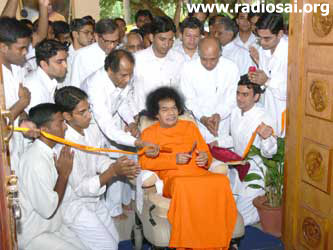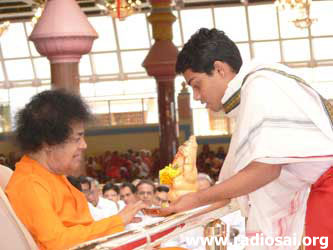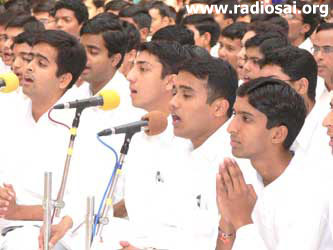PRASHANTI DIARY
CHRONICLES OF HEAVEN ON EARTH
As probably most of you know by now, the biggest happening last month in Prashanti Nilayam was the Ati Rudra Maha Yagnam, a 12 day long celebration on a scale rarely witnessed in history, a celebration that was unprecedented as for the first time a yagnam or “sacrifice” to Lord Shiva was offered in the presence of the Living God Himself.
The tone for this momentous event was set quite a few days earlier, on July 30, 2006, when the students of the Sai Mirpuri College of Music celebrated in song the role of Lord Shiva in the birth of Music. This was followed a few days later by the Varalakshmi Puja, a puja (prayer) which history states was revealed by Lord Shiva to Mother Parvathi when She asked Him to give a boon to all married women for the well being and prosperity of their husbands. These two events, memorable and important in their own right, set everyone’s thoughts this month to the munificence of Lord Shiva and all that He has done and continues to do for the benefit of humanity.
This was fittingly followed by the Ati Rudra Maha Yagnam, a unique form of worship of Lord Shiva performed to establish an environment supremely conducive for spiritual growth and for the washing away of one’s sins. This holy ritual was also a prayer for the prosperity and protection of mankind (loka kalyanam and loka kshemam) and also satisfies worldly desires which if used virtuously can confer a lot of spiritual merit.
JULY 30, 2006: “SANGEETHA NAIVEDYAM” - A VOCAL AND INSTRUMENTAL FUSION PROGRAMME
This program, a vocal and instrumental fusion program that was lovingly offered by the Music College students, started with a Ganesh stuthi entitled “Naada Pushpanjali”.
This song (Shravana Sunadara Naama Ganapathy) in raag Hamsadvani symbolises Lord Ganesha who Himself is a musician.
Lord Ganesha’s instrument is the Pakhavaj (a barrel shaped percussion instrument) and this song that they selected contained pakhavaj bols which emerged from Lord Ganesha’s Pakhavaj, thus highlighting the passion that Lord Ganesha had for rhythm. The instruments used to accompany the vocals were the sitar, the tabla, the mridangam, the harmonium and the key-board.
Music was born from Lord Shiva, the Cosmic Dancer. Sri Thyagaraja enlightens this in his famous song “Naada Thanumanisham Shankaram Namami Mey Manasa” in raag Kharaharapriya. Saptha swaras (seven notes) emerged from the five faces of Shiva namely Sadyojaatam, Vaamadevam, Aghoram, Ishanam and Tatpurusham. Therefore Lord Shiva is also called Panchanana (the one with five faces).
|
|
|
| |
|
The concert in progress |
From the scales of the Sama Veda innumerable ragas emerged and then from the divine damaru (small two-headed drum) of Lord Shiva emerged 5 rhythmic patterns – Thisra, Chaturasram, Khandam, Misram and Sankeernam. “Rudra Tandava”, presented next by the boys, depicted the birth of these ‘swaras’ and ‘talas’. This was a fusion of the popular song on Shiva – Bho shambho Shiva Shambo Svayambo in raag Revathy, and the bhajan Bhasmabooshi thaangaa Sai with rhythmic varieties. The instruments used in this piece were the veena, the mridangam, the tavil, the harmonium, the kanchira, the keyboard and the octopad.
The third item they presented was a thillana (Naa diri diri dheem than a na) in raag Kadanakuthuhalam, a raga that gives joy. And their last song for the evening was a famous Western composition called “Heartbeat” by Sri Muthiyah Bhagavather in raag Sankara Bharanam. ‘Heartbeat’ was sung with the accompaniments of the veena and the mridangam. All in all it was an enjoyable evening, a fitting precursor to the magnificent Ati Rudra Maha Yagnam to follow in a few days.
AUG 4th: VARALAKSHMI PUJA IN SAI KULWANT HALL
In August 2000, Swami explained about the origins of the Varalakshmi Puja. Swami said, "Legend has it that Parvati once asked Easwara (i.e. Lord Shiva) if there was any way to ensure the auspiciousness, prosperity and well-being of women. She desired that every woman should lead a long, happy and healthy life with her husband, children, grandchildren, friends and relatives. Easwara was pleased with Parvati’s prayer and told her about the Varalakshmi Vrata, which would confer all a woman may ask for. This particular Vrata is a boon for all women."
"Easwara revealed the sacred Varalakshmi Vrata to Parvati, so that future generations might perform this Vrata and derive the benefits there from. The Purohit (chief priest) has enumerated the benefits which this Vrata confers. When a woman performs the Varalakshmi Vrata, she gets the blessings that she may live long with plenty and prosperity as a sumangali (a woman whose husband is alive) with her children and grandchildren. Varalakshmi protects seven past generations and seven future generations. Noble women like Savitri and Anasuya enjoyed peace and prosperity by performing this sacred Vrata. The purpose of Varalakshmi Vrata is to atone your sins, develop sacredness and ultimately lead you to Divinity."
|
|
|
Decorated Dais |
|
Decorated Steps |
On August 4th, 2006, another grand Varalakshmi Puja was performed in the divine presence for the second year in a row. This year nearly 1500 women from all over India as well as from abroad participated in this function held in the divine presence to pray for the well being of their husbands and their families.
Sai Kulwant Hall was beautifully decorated this day with pieces of lawn and with small Lakshmi Statues adorning the steps of the veranda. The centre of the veranda dais, right in front of Ganesha was done up as a floral pandal (protective structure) resting on 4 columns wherein a beautiful silver statue of Goddess Lakshmi was installed. On either side of the veranda a floral portrait of Mother Lakshmi, done by using flower petals of different hues, was also placed to lend the right ambience to this holy day.
|
|
|
Swami Lighting The Candle |
|
The Priests Conduct The Puja |
|
|
All the women were seated in rows in front of the dais with a plate in front with all the necessary ingredients for the puja. The ladies were all dressed alike in a silk sari and the entire hall had a festive and august ambience that provided the right setting for the conduct of this sacred ritual.
After Swami arrived at the Hall to the sounds of veda chanting, He lit the lamp to signify the start of the proceedings. Then the priest after obtaining Swami’s blessings led all the women in the conduct of this ritualistic worship that lasted for approximately 45 minutes. At the conclusion of the ritual the priest also briefly related the story of the origin of this puja for the benefit of the participants. All the participants were later served a sumptuous lunch in the South Indian canteen. |
Women performing The Puja |
|
|
AUG 9th to 20th, 2006: THE ATHI RUDRA MAHA YAGNA
| |
|
|
| |
A Panoramic View Of The Yagna |
|
Then finally dawned the day that devotees from all over the world and deities in Heaven, were waiting for with bated breath – the Ati Rudra Maha Yagnam. A lot of the background material on this yagnam has already been reported in numerous forums earlier and this event also forms this month’s cover story on Heart2Heart, but for the sake of continuity as well as completeness of this article we will digress a bit to give a brief back-ground (even at the risk of repetition) in order to link all the aspects of the story we want to tell you about this momentous event. We seek the readers’ understanding of our indulgence.
WHAT IS THE ATI RUDRA MAHA YAGNA?
The Ati Rudra Maha Yagnam is very sacred and has been performed since antiquity to drive out the calamities and difficulties of mankind. Let us first understand what these strange words mean.
Yagnam? A lot of confusion prevails about the terms yaga (or yagya) and yagna, which are commonly used as synonyms in informal conversations and normal understanding. However there is a difference. ‘Yaga’ means the offering (or sacrifice) of certain traditionally sacred and valuable items like cow’s ghee (clarified butter), fruits, flowers, sesame seeds, rice, and other such sacred offerings to the fire in a havan or homa kundam (a fire pit constructed according to certain norms), as the fire is the vehicle to transfer the essence of these items to celestial deities like Indra, Rudra, Varuna etc.
Why do we need to propitiate these deities? The Vedic literature indicates at many places that the jiva (or the individual) and the deva (or the Gods) exist in a cooperative manner; one supporting and feeding the other. As an example, Verses 10 through 13 of Chapter three in the Bhagavad-Gita contain a clear reference to this: |
|
|
| |
|
Banner of Program |
"Having created men along with yagya, the Lord of Creation (Prajapati) said: 'By yagya you will prosper and its performance will bring forth the fulfilment of your desires. Through yagya you nourish and sustain the gods and those gods will, in turn, sustain you. By sustaining one another, you will attain the highest good. Nourished by the sacrifice, the gods will bestow on you the enjoyments you desire. But he who enjoys their gifts without offering to them is merely a thief.'"
Why is fire used? There are also two reasons for the use of fire as the preferred means of conveyance of the essence of the yaga or (yagya) to these deities.
|
|
Firstly, fire is the only element that does not get polluted by contact with any other material, and secondly the smoke emitted from the homa kundam during the yaga purifies the entire atmosphere. These types of yagas will grant happiness to mankind, good health to all humanity and also earn the Grace of God.
The term Yagna on the other hand has a more inclusive meaning – it not only includes yagas (or the fire sacrifice portion) but also Adwaram. Adwaram means the journey towards God through good deeds.
It is moot to note that the term used here for this momentous event was the Ati Rudra Maha Yagnam (i.e. yagnam in its fuller sense). So while over these 12 days we witnessed the Yaga portion of the Yagnam, clearly the journey to God has only just begun. It is up to us individually to further sanctify our lives and earn His grace through good deeds as a continuation of the spiritual momentum generated by this Ati Rudra Maha (great) Yagnam that was just concluded in Sai Kulwant Hall. |
Fire Coming Out Of A Homa Kundam |
|
|
Rudram is another name for Lord Shiva. One who removes difficulties, one who teaches ‘Atmavidya’, one who uplifts dharma, one who grants emancipation, one who grants wisdom and even one who on doomsday punishes evil-doers is called Rudra. The term Rudra is commonly (and mistakenly) associated only with the angry aspect of Lord Shiva, the aspect with which He destroys evil, though Lord Rudra is expressly concerned with the total well being, protection and emancipation of humankind.
The Sri Rudram chant (called the Namakam) is an ancient Vedic hymn, and is the oldest example of a listing of various names of Lord Siva. Through the chanting of the Namakam, Lord Siva's various attributes and aspects are invoked and worshipped. Describing the several facets of Lord Shiva by reciting the Namakam is also called ‘Rudra Prasna’.
The Rudra prasna can be done with or without the accompaniment of a Vedic yagna ritual. When accompanied with the Vedic fire ritual, it is called the Rudra Homam or the Rudra Yagnam.
In the Taithareeya Samhita, 4th skanda (chapter) – the 7th sub-stanza is known as ‘Chamaka’. In this section, the letters ‘cha’ and ‘mey’ appear repeatedly and it is hence known as Chamaka. Those who are interested in worldly gains and riches, pray to God to grant them all types of ‘boons’ and hence this prayer is known as the ‘Chamakam’.
|
|
|
Ganesha Gate Decoration |
|
Decorated Ganesh Temple |
So what is the Ati Rudram? To understand this, we have to do some basic mathematics.
Eleven recitations of the Sri Rudram (Namakam) followed by one recitation of the Chamakam is called the Ekadasa Rudram. This also constitutes one unit of the Rudra Homam.
Eleven Ekadasa Rudram recitations make one Laghu Rudram. (11x11=121 times of Namakam and 11 times recitation of Chamakam). This is achieved if 11 priests chant 11 times the Namakam and 1/11 of the Chamakam for every single recitation of the Namakam. [Editor’s Note: The Namakam and Chamakam are each divided into 11 anuvakyas or sections. Hence for each recitation of the Namakam they chant one anuvakya or 1/11 portion of the Chamakam].
Eleven Laghu Rudram recitations make a Maharudram (11x11x11=1331 Namakams and 121 Chamakams). This is achieved if everyday 11 priests chant 11 times for 11 days.
And eleven Maharudram recitations make an Ati Rudram! Thus, in an Athi Rudra Maha Yagnam, the Namakam will be recited 14,641 times and the Chamakam 1331 times, with the performance of 1331 Rudra Homams by 121 Ritvik priests. (121 priests x 11 times per day over 11 days).
So one can ask the question - if this yagnam is being performed since time immemorial for conferring spiritual benefit and for loka kalyanam and loka kshema, what is the necessity of reciting the Chamakam, which confers mere material benefits. The Chamakam (in this context) is now a prayer to the Lord to provide all the articles required for the homam. The list is exhaustive and comprehensive, from lentils of several varieties, to fuel, ghee and fruits. The usage of material things in the service of the Lord is after all one of the highest form of devotional service.
The 121 priests are spread over 11 homa kundams (fire pits), with each kundam associated with 11 priests. Apart from these 121 priests there will be 14 other priests who will do pujas to various deities, thus totalling to 135 ritviks who will take part in this yagnam. A detailed explanation of the importance of the number 11 is given in the box below.
THE CONSTRUCTION AND LAYOUT OF THE YAGYA SHALA
This really begs the question – why the fascination with the number 11? The answer is quite simple as there are 11 primary names of Lord Shiva. Hence the Yagya mantapa or the Yagya shala (the sanctified place where the yagya will take place) had 11 homa kundams, specially set up for the occasion in Sai Kulwant Hall. Each homa kunda was in the shape of a square of length 5 feet. It attained a height of 3ft over three tiers.
The homa kundams were constructed of bricks and cement and then painted over. The base of the homa kundam had a refractory material that could withstand high heat. The homa kundams were filled with sand on the inside up to a height of a foot or a foot and a half and in this pit the wood was burnt to generate the fire to convey the offerings. The layout of the yagya shala is represented in the figure above. |
|
|
|
Yagya Shala |
|
View Of Homa Kundams |
Each of the homa kundam is associated with a name of Lord Shiva. The Central or main pit (No 1) is associated with the name Mahadeva. The names associated with the other homa kundams numbered 2 through 11 in the figure are: (2) Devadeva, (3) Ishwara, (4)Vijaya, (5) Adityatmaka Rudra or Sri Rudra, (6) Bheema, (7) Shiva, (8) Rudra, (9) Neelalohita, (10) Bhavodbhava and (11) Shankara.
|
In addition to these 11 homa kundams, kalasams (sacred pots) totalling 160 were placed near the Homa Kundams: 132 kalasams for Lord Shiva and 28 kalasams for the other Vasthu devatas (or the subordinate Gods).
A curved pot full of water on which a coconut is placed surrounded by mango leaves or the equivalent is called a kalasam. This kalasa can be quite simple or elaborate depending on the event or preferences. The curved pot called kalasam contains water from one of the holy rivers of India.
The water from some of the holiest rivers of India were also placed in a separate stand and labelled with the name of the river from which the water was collected. A Kalasa puja was performed in honour of the seven rivers of India and to invoke the god Varuna to bless and purify the water.
|
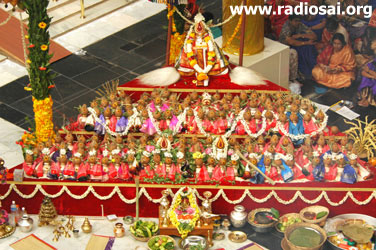 |
|
|
Kalasam Stand |
|
Water Stand |
The whole Yagya Shala was constructed with permitted materials in front of the veranda dais. The pillars supporting the constructing were made from the wood of the Araca Nut tree as was the top side railing. Decorations of tender coconut and araca nuts lined the pillars and the top of the railing. The base of the pillars was held in place by huge boxes filled with sand and topped up with painted tender coconuts. Metal strings were also used to tie the structure to the columns in Sai Kulwant Hall for further stability. Ferns and coconut leaves were woven together to form a sheltering fabric for the Yagya shala. The top portion of the Yagya Shala was entirely open so as to provide an exit for the smoke that was generated from the offerings to the 11 homa kundams! And on some mornings Swami even had the rolling roof of Sai Kulwant Hall opened to let the smoke out.
|
|
|
|
Decoration Pillar |
|
The Decorated Veranda |
Additionally the veranda was also exquisitely decorated. A floral arch was constructed around the Lord Ganesha statue and some oversized decorative lingams were also placed on the veranda to provide the right ambience. Amber coloured focus lights also lent a homely warmth to the veranda.
An ornately decorated table with a marble top was placed immediately in front of the veranda and on this the abhisekham (bathing ceremony) of the marble Shiva linga was carried out during the entire yagnam. This Shiva linga was installed on a silver base called ‘Pannupattam’.
|
|
|
| |
|
Shiva Linga |
As per the ‘Kurma Purana’ this Athi Rudra Maha Yagna was performed in Dwapara Yuga by Lord Krishna. In the Treta Yuga, Lord Sri Rama also performed the same as per Hindu Vedic scriptures. This is the first time in the history of Kali Yuga that this yagna is being performed when Lord Sathya Sai is in the “Siva Sakthi” avatar amidst us as Lord Rudra.
This yagnam was started on August 9th, when ‘Sravana’ star was in sway (which is the birth star of Lord Vishnu) and ended on August 20 th in ‘Aarudra Star’ (which is the birth star of Lord Sathya Sai).
The programme began on the morning of the 9th itself when Swami, the Rudra Avatar Himself, presented the 135 rithviks (priests performing the Yaaga) with sets of ceremonial clothing to be worn during the Yaaga.
This distribution ceremony called Acharyadi Ritvik Varana was done in the holy precincts of the bhajan mandir of Sai Kulwant Hall where the priests had assembled early in the morning. After the distribution, the priests chanted some mantras in the Divine presence before the conclusion of the morning’s ceremony.
Then for the next 12 days we had an unimaginable gourmet spiritual treat in store. The yagnam rituals performed over these days can be broadly classified into 4 different categories:
|
|

|
| |
|
Priests Coming Out Of Bhajan Hall With Clothes
|
1.The ceremony of the 9th evening when the lingam was purified for installation.
2. The Installation ceremony on the morning of the 10th, which included the rudra parayana, linga abhisekham and rudra homam.
3.The morning and evening ceremonies from the third day to the 11th day which were identical and repeated every day.
4.The Poorna Ahuti or the concluding ceremony on the morning of the 12th day.
Every evening after the conclusion of the afternoon (and the day’s) ceremony all the priests took their places in front of the veranda and it was the turn of one or two eminent speakers to educate everyone on one aspect of Shiva or to elucidate some aspects of the yagnam that was being conducted. All these speakers were either accomplished Vedic scholars or eminent men known for their deep spiritual knowledge and all of them held everyone spellbound with their oratory and the sheer wealth of the spiritual experience that they shared with the audience every day. And on almost all evenings, Swami also pleasantly surprised everyone with His divine discourse. And after the speeches there would be devotional songs either by budding artistes from Karnataka or on Swami’s command the SSSIHL boys would perform.
|
|
|
Vedic Scholars Gave Speeches |
|
Eminent Men Inspired The Audience |
In order to present this material in a readable and understandable manner, we depart a bit from our normal format of reporting the events in a chronological manner. We will first talk about the yagnam per se following the 4 grouping that we listed above. Normally we also report on all the speakers, but as some extracts from their speeches has already been reported in the cover story we will not repeat it here again.
The full text of the divine discourses is also already available on-line (click here), so we will again not follow our normal practise and bring you summaries that contain the essence of what Swami said that day. We will, of course, bring you these speeches and divine discourses on Radio Sai so we hope you are able to listen to them either through the Radio Sai Global Harmony or through our audio streaming service. To download the chants of the Vedic priests, click here.
We will however, report in full on the musical events that took place almost every day and we sincerely hope that you like this changed format of the report for this month only. |
|
|
| |
|
Divine Discourse |
The Function On The 9th Evening (The First Day)
The evening of the 9th was the start of the yagnam. All the rithviks, chanting vedic hymns and accompanied by auspicious Nadaswaram music, entered Sai Kulwant Hall in a procession and received Swami with the Purna Kumbha. Swami lit the lamp to inaugurate the Yaaga.
|
|
|
The Priests In Procession |
|
Swami Lighting The Lamp |
After lighting the lamp, Swami took His seat on the veranda. The yagnam started with the invocation song, sung by the bhajan group from Brindavan, entitled "Athi Rudra Maha Yagna Purusha Sai".
Swami asked Sri Vinay Kumar and Sri Lakshmi Narayan to speak to the audience. Sri Vinay Kumar recounted how when he had asked Swami’s permission to perform the Ati Rudra Yagnam on June 13th for Rudra’s joy and satisfaction, Swami had replied, “But I am always joyous and satisfied”. He went on to explain how the yagnam would be performed. Sri Lakshmi Narayan, also a co-organiser speaking next also related Swami’s involvement in all aspects of planning for the yagnam.
|
|
|
Sri Vinay kumar |
|
Sri Lakshmi Narayan |
|
|
After these two speakers, Sri Nanjunda Dikshitar, the chief rithvik, gave a very illuminating talk on the significance of the Athi Rudra Mahaa Yaaga. After these talks, Swami unexpectedly gave a Divine Discourse. He said,
“Athi Rudra Maha Yajnam is noble and sacred. Those who perform it are blessed. The key is to do it with unity. This will lead to purity and then to divinity. The 6 vices are your enemies. Keep them away. You are all embodiments of the ATMA. Be happy, healthy, peaceful and spiritual. But one cannot be happy without devotion. Immerse yourself in devotion and not the deep ocean (of Samsara)”.
|
Divine Discourse |
|
|
After Swami sat down, the Head priest obtained Swami’s blessing for the implements with which the puja would be done. The Yaaga then began with the Maha Ganapathi Puja, after specification of the place and time of the Yaaga in the traditional way:
|
|
|
Priests Getting Swami’s Blessings |
|
A View Of The Puja |
"In this spacious Universe, on Earth, on the continent of Jamboodvipa, in the land of Bharat (India), in the State of Andhra, in the holy pilgrimage site of Puttaparthi on the banks of the holy Chitravathi River, in the year Vyaya, during Dakshinaayana, on the first day of the month of Sraavana, on Budhavaar ( corresponding to Wednesday, August 9, 2006), until the 12th day of the month of Sraavana, Aadivaar." (Sunday, August 20).
Afterwards Svasthi Vaachanam, Svasthi Punyaaha Vaachanam (prayers for auspiciousness and blessings for the Yaaga and the people) took place.
This is for the negation and purification of any inadvertent errors in conducting the Yaaga, or any impurities in the materials used. This is traditionally done before any auspicious religious ceremony is conducted.
Next was the Raksha Bandhan Ceremony to the newly made Sivalinga, for auspiciousness and protection. Swami also created a beautiful golden bracelet and personally put it on Sri Vinay Kumar, the Sri Sathya Sai Karnataka Youth leader, who along with the youth of Karnataka conducted the Athi Rudra Mahaa Yaga, under the guidance and blessings of Bhagavan. |
|
|
| |
|
Bracelet for Sri Vinay Kumar |
The milk white marble Shiva Linga was ceremoniously bathed in water in ‘Jala Proshana’. Then Purvaanga Godaana was performed. A well-decorated cow and her calf were welcomed with auspicious music and vedic hymns, worshipped with mantras according to the Shastras, and then given away to a Brahmin. Among all auspicious good deeds, the gifting of a cow is traditionally considered the highest and holiest act of charity.
|
|
|
Bathing The Linga In Water |
|
Worshipping Of Cow And Her Calf |
|
|
In the Yagna Hall, the Lord in His many Forms was invited with prayers to install Himself in the forms of many kalashas in a ceremony called as kalasha sthapana. [The kalasha is a pot filled with water, and topped with mango leaves and a coconut. The kalasha has many symbolic meanings - it represents the Primordial Waters, the Super Soul filled with love and compassion, abundance, and hospitality. The mango leaves are for auspiciousness. The coconut is a symbol of the Godhead, the eyes of the coconut symbolic of the three eyes of the Lord.]
For the correction of any errors in Vaasthu (location and construction), deviating from Scriptural guidelines, Vaasthu Puja to all the eight deities like Yama, Varuna, Agni, Vayu, Kubera etc. was performed. |
Another View Of The Puja |
|
|
Pancha Gavya Aaraadhana was also performed (Panchagavyas are cow’s milk, cow ghee, cow dung, cow urine, and yoghurt made of cow’s milk) These five items were used in this yagna and hence the process of sanctifying them is called “Pancha Gavya Aradhana”.
Subsequently, various pujas were conducted in accordance with the shastras. The Shiva Linga was bathed or anointed for some time successively with water, milk, rice, flowers, fruits, honey and sugar. This seva is traditionally performed during installation and consecration of deities, as directed by the shastras.
Then around 4:30 PM “Bimba Suddhi” puja was performed to the newly brought lingam. (This means removing all the mistakes committed while carving the lingam by the sculptor).
Then rituals (done to a newly born baby) known as ‘Pumsavana’ (3rd month ritual); ‘Seemantham’ (6th month ritual), Dasama Maasa Jananaartham (removal of doshams in the tenth month) etc. were also performed. |
|
|
| |
|
Bathing The Linga With Milk |
The installation and consecration of the Lord in this particular image or form of the Shiva Linga, is considered equivalent to the Lord being born in this world in this form, so all of the Shastric rites conducted during birth were also performed for the Shiva Linga.
|
|
|
The Lingam In Its Stand |
|
The Lingam Is Placed In A Bed Of Flowers And Fruit |
[The lingam is traditionally used to represent Lord Shiva and has a deep meaning and significance. It is considered the “amorphous’ form of Lord Shiva. The Lord is in the 3 forms i.e. the formless state of God, the lovely ash-smeared form of Lord Shiva with the blue throat and the snakes around His waist that we are all familiar with, and in the lingam – the amorphous state of formlessness and yet also with form, as the lingam has no defined beginning and end. The lingam is thus indicative of the beginningless and endless Brahman. Lingam is a combination of two words namely Leeyathe (mergence) and Gamyathe (emergence) suggestive of the creation and dissolution of the Universe].
The Shayyadheevasa ('sleeping' of the Lord) was next performed. The lingam was literally placed in a cozy bed with fruits, flowers and incense. Lullaby was sung and music played in 5 ragas as the two chamargrahas (fan bearers) gently fanned the Lord. Sentries - Indra on the East, Agni (S.E), Yama (S), Nirariti (SW), Varuna (W), Vayu (NW), Kubera (N), Shiva (NE), Brahma (above) and Ananta (below) - were posted to ensure a peaceful rest to the Lord!
With these Agama Shastra Rites, the Ashtavadhana Seva, the day’s ceremonies concluded with the Maha Mangala Aarathi. As the Lord retired, arthi was sung and the eventful evening came to a close at 6:45 PM.
|
|
|
Fanning The Lingam To Sleep |
|
The 100 Wick Lamp Arathi |
The Function On Aug 10th - the Second Day
On the morning of the 10th, the entire ‘packed to overflowing’ hall was abuzz with excitement. At the centre of the hall was an ornate table in wood with a marble topping on which was placed the pedestal with the lingam. The priests had begun the day by getting the lingam ready for Swami to do the prana prathista (installing life in the lingam).
The first ceremony was Aruna Parayana, followed by Kalaa Homa and Anga Homa. Kalaa and Aavaahana were performed for the Shiva Linga. Aavaahana was performed to all the kalashas with Veda Mantras. Before Praana Prathishtapana (invocation and consecration of the Life Force) was conducted for each kalasha, all of the necessary ceremonies required by the scriptures were performed, including “Netronmeelana” to the Siva lingam. Netronmeelana means opening of the eyes of a new born baby (in this case the Siva linga).
|
|
|
Performing the Aruna Parayana |
|
Performing The Preparatory Puja |
The white-stone lingam sat on its silver pedestal. On it was smeared a “third eye” of sandal paste and vermillion. It was decorated with a garland of bilva leaves. It had above it a silver-golden bowl, hanging from a support, with intricate carvings and studded with precious gems. This silver bowl was called the “Dhara patram”, and it had a small hole at the bottom. When this vessel was filled with a fluid – either water or milk etc., it flowed out through the hole in a continuous stream on to the lingam below, giving it an abhisekham (a ritual bath).
Swami came out of the Yajur Mandir around 6:15 AM and got down from the car in front of the lingam itself where He was welcomed by the head priest with holy water to be offered to the Lingam. He was helped on to a pedestal and He sprinkled water on the lingam with the aid of a long brush braided from holy grass, while the ritual prayer was being recited by the priests.
|
|
|
Closeup Of The Linga With Dhara Patram |
|
Sprinkling Sanctified Water On The Lingam |
Then to everyone’s astonished gasps, with the merest wave of His hand, Swami materialized a “third eye” for the Lingam. It was a “namam” [namam refers to the three parallel vibhuti lines that followers of Lord Shiva apply to their foreheads] of three lines made of gold plate with a red gem at its centre. Swami Himself placed the “eye” on the lingam and stuck it there and completed the picture.
|
|
|
Materialising The Third Eye |
|
Sticking It On The Lingam |
The priest then performed arathi to the lingam and Swami together. Swami then went walking around the table, up the steps and took His place on the veranda. Thus after the installation of the Shiva Linga with Vedic rites, Swami Himself had performed the Praana Prathishtapana for the Shiva Linga and the Siva lingam was now born and considered to be imbued with life. The yagnam began with a song in Tamil by a 13 year old boy Karthick calling out to Lord Sankara as the mother and the father of all mankind. It set a tone of devotion to the entire proceedings.
After the Birth Ceremony, the Naming Ceremony was performed. Swami Himself gave the Shiva Linga the name “Sai Easwara”. The Head priest (Sri B.S. Nanjunda Dixit) made this announcement to the congregation to the utter delight of everyone assembled there.
|
|
|
Closeup Of Lingam With The Third Eye |
|
Announcing The Name |
Around 7 AM after Swami had sat on the dais, two priests took the wooden sticks (the Arani or the churning equipment for the creation of fire) and had it blessed by Swami in order to generate the fire. The fire caught in just two minutes. Then the pundits showed the fire to Swami and placed it in the main homa kundam and “Agni Pratishta” (installation of fire) was done that way.
GENERATING THE SACRIFICIAL FIRE |
It is a practise at all yagnas that the fire is only lit naturally through friction and this is called Arani. Generally two sticks are churned on another log and the heat generated by the friction lights up the dry grass with which it is in contact. Once the dry grass catches and wisps of smoke are seen, it is carefully kindled into a fire and transferred to the main pit.
|
|
|
|
Getting The Arani Blessed |
|
Churning The Rods To Generate The Fire |
|
|
|
|
|
|
The dry grass catches fire from the heat |
|
The fire is transferred to the main altar |
Once the ‘Agni’ (fire) was established in the main homa altar, it was distributed to the other 10 homa altars, which were successively lit. This is called ‘Agni Vibhajana’ or separating the fire, by taking a burning stick from the main homa kunda and placing it in the other 10 homa kundams.
|
|
|
A Cinder Is Taken From The Main Altar |
|
Cinder Lights Up The Secondary Altars |
Simultaneously, Panchaamritha Abhishekam was performed to the Sai Easwara Lingam (bathing with five sanctified substances: milk, yoghurt, ghee (clarified butter), honey, and sugar), and in addition with coconut water, flower essence water, turmeric water, kumkum water, sandalwood water, vibhuti water, etc. accompanied with the chanting of vedic hymns.
|
|
|
Abhisekham With Curd |
|
Abhisekham With Honey |
After the panchamruta abhisekham ended, Rudra Abhishekam was performed with Rudra Paaraayana (recitation of the Rudra). The priest poured the milk into the silver cup above the Lingam from which there was a steady trickle of milk onto the lingam, while the Namakam was continuously recited for the requisite number of times as recounted above.
After the completion of the Rudra Paarayana, Rudra Homa was done. In the Rudra Homa, Rudra mantras are chanted, each ending with “Svaaha” while offering ghee and other items to Lord Agni in the homa kundam. The main priest pours the ghee with a wooden spoon, and the other priests sitting around the homa kundam throw articles like rice, flowers, etc together.
|
|
|
Rudra Abhisekham |
|
Rudra Homa with All Priests Pouring Ghee |
|
|
After the Rudra Homa, Sai Gayathree Homa was performed, and the Sai Gayathri was recited 108 times.
Later, pujas were performed to the Shiva Linga, with Ashtaavadhaana Seva: Ekaarthi, Thriyaarthi, Kumbhaarthi, Panchaarthi, Radhaarthi, followed by Maha MangalaAarathi. Prasad was then distributed to the devotees.
In the afternoon, the pujas began at 2:00 PM. Auspicious Nadaswaram music, Rudra Paaraayana, Panchaamruta Abhishekam, Rudra Abhishekam, Vibhuthi Archana, Nivedana - Shodashopa pujas were conducted.
In Swami’s presence, after the talks by learned scholars and then Swami’s Divine discourse the programme ended with Maha Mangala Aarathi. |
Vibhuthi Abhisekham |
|
|
The Function On The Next 9 Days
From the third day to the eleventh day, the homas and pujas were conducted in a similar way and the same sequence was repeated on all days.
The programme used to start early at 5:00 AM. The morning programme had 3 distinct components:
- Auspicious music early in the morning, followed by Aruna Paaraayanam, Mahanyaasa Paaraayanam, Panchaamruta Abhishekam
- Shiva Linga Abhishekam (of continuous stream of milk and later by water) accompanied by Rudra Paaraayanam by all the assembled priests and
- Rudra Homam, Sai Gayathree Homam, Maha Mangala Aarathi and Ashtaavadhaana Seva.
Before the priests started in the morning, in a ritual called as sankalpam they would seek the blessings of the Gods to perform the day’s rituals in an error free and perfect manner as laid down in the shastras.
Thus with purified minds and firm resolve after obtaining the blessings of the presiding deities, all the priests would commence the day’s rituals.
|
|
|
|
Nadaswaram music in the early morning |
|
Sankalpam |
After the Panchaamrutha Abhisekham, the entire table was cleaned and all the abhisekham materials (fruits etc) were collected from a spout on the edge of the table into a vessel below. These holy ingredients were later (after the morning’s yagnam) distributed to all the devotees as theertham or the sanctified liquid prasadam from the proceeds of the yagnam. The lingam is also bathed again with water and then wiped clean with a new towel. Then the lingam is “dressed up” with a shawl and a variety of flower garlands and thus made ready to oversee the homam that commenced next.
|
|
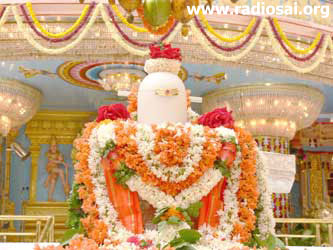 |
Dressing Up The Lingam |
|
The Lingam In Its Full Glory |
It must be noted that for the Rudra Paaraayanam while the number of priests reciting were supposed to be 121, in actual fact it was a lot more, perhaps in the thousands. Swami asked all the vedam chanting boys also to come dressed in dhotis for the recitation. The vedam boys wore a red dhoti and a white angavastram (upper cloth) and sat in front of Swami for the Rudra recitation during all the days. Additionally, the entire student body from all the 3 campuses as well as the Primary and the High School students also chanted the Namakam along with the priests. Additionally, quite a few of the devotees who either knew the mantra or had brought the mantra book with them also chanted along over the approximately 2.5 hours it took to recite the Rudram 11 times and the Chamakam once.
| |
|
|
| |
The vedam group in front of Swami |
|
And after the completion of the paaraayanam, the head priest went to seek Swami’s blessings to do the homam or the fire sacrifice portion of the morning’s rituals. Following the ancient Bharatiya culture the priest very respectfully covered his mouth with his fingers as he talked with Him (so that the spittle from the mouth is guarded by his palm). After obtaining Swami’s blessings, the priests all went and took their places by their respective kundams and at the end of each mantra a handful of offerings were put into the fire.
|
|
|
Head Priest Talking To Swami |
|
Homa Offerings |
And after the completion of the Gayathri Homam along with recitation of the Sai Gayathri the morning programme was almost over. Once the homam was over, one of the priests would take a pinch of the ash from the main altar and making a paste apply a ‘tilak’ of the ash to the Sai Easwara lingam.
But before the mangal arathi was taken every day in the morning, Sri Karthick used to sing a brief song praising either Lord Shiva or Lord Sai. These were very melodious and most appreciated by all. Deep was their meaning too - as for example on one day he sang, “Enda Idam Chendralum, enda mugam partalum, inda mugam thereyudai, Sayee Mugame Sathya Sai mugame”. “Wherever we go, wherever we see a face, we see only this face, the face of Sathya Sai”.What profound sentiments! No wonder this young boy Karthick became a firm favourite of the Lord, with the Lord many times enquiring about his welfare during the twelve days of the yagna.
|
|
|
| |
|
Applying the tilak to the lingam |
|
|
|
Sri Karthick Singing |
|
Arathi At Conclusion |
And after Sri Karthick had finished, there used to be a melodious nadaswaram tune to round off the morning’s prayer, before taking the arathi to conclude the morning’s session.
In the days of yore, Sage Vishwamitra had the young Lord Rama and brother Lakshmana protect the yagya shala from the attacks of the rakshasas.
|
|
According to tradition and as part of the ritual, a few kalasams were spread around the yagya shala according to the prescribed norms. Puja was done at prescribed times to the deities associated with these kalasams to invoke the respective deities to protect the yagnam from adverse forces.
And not to forget! It was only because of Lord Sai Rama’s benign protective gaze from His seat on the veranda and his copious blessings that this yagnam was so well protected and was performed so flawlessly.
The afternoon program used to start daily at 2:00 PM. After the auspicious music, Nithya Homam was performed. Panchaamruta Abhishekam, and Sri Sai Gayathri Homam would also be done in the afternoon followed by Rudra Krama Archana Puja. And after the completion of the afternoon’s puja, all the priests would take their place in front for a vantage view of Lord Rudra and listen to the afternoon’s speeches and music programme.
|
Kalasam Puja In Corner |
|
|
The credit for the success of this stupendous yagna is not only due to the organising prowess of the youth of Karnataka, but also due to the 135 priests who conducted the programme. Swami Himself acknowledged this explicitly in His discourses and also said that the bonds between Him and the priests were unbreakable. And as a visible measure of His immense pleasure, He rewarded the Headpriest (as being the representative of all the priests) in many tangible ways. On the morning of the 18 th also, He also manifested a gold chain with a crystal lingam as the pendant and personally put it around the priest’s neck.
|
|
|
Priests Sitting In The Front |
|
Gold Chain For The Priest |
And perhaps as a measure to indicate that all the Gods in the Heavens were also pleased with this yagna, on the evening of the 19th, the penultimate day of the performance of this yagna, a very beautiful rainbow light up the Eastern skyline of Puttaparthi.
The Poorna Ahuti Function On The 12th And Concluding Day
It was the concluding day of the Yagna culminating with “Poorna Ahuti”, and by prior intimation the yaga had started very early at dawn at 4:00 AM with 'Aruna Parayanam'.
The massive crowd had collected even earlier with some standing in line from 12 AM to get entry and a good vantage position. The yagya shala had been spruced up for this important concluding ceremony with fresh flowers and decoration adorning this sacred space. Noteworthy was a beautiful statue of Lord Shiva that was brought just for this concluding morning’s session and occupied the pride of place at the front of the yagya shala.
|
|
|
The Beautiful Idol Of Lord Shiva |
|
A Section Of The Crowd |
Following the pattern of the last 10 days, the ‘Aruna Parayanam’ was followed by Mahanyasam and Panchamrutha Abhishekam, and the Siva Linga Abhisekham accompanied by the last 1331 chants of Rudram (to bring the total chants done during the yagna to 14641), the Rudra Homam and the Sai Gayathri Homam. The ritviks were very energetic and enthusiastic, eager to continue and bring the yagnam to a successful conclusion.
Similar to the first day, on this concluding day also “Uttaranga Godanam” – a cow and a calf were donated to a Brahmin.
It was close to 8:15 in the morning, when the Rudra Homam was also completed after the completion of the Rudra Parayana.
|
|
|
Homam On The Concluding Day |
|
Godanam |
Then “Maha Poorna Ahuti” was started by and performed in the presence of Swami. A beaming Swami sat Himself between the Sai Easwara lingam and the main homa kundam and watched the proceedings keenly.
The Head priest then did “Vasodhara” Homa duly uttering the requisite Vedic mantras. In this ritual cow ghee is poured in a continuous stream into the main homa kundam through a special silver spoon, and all the while the priests utter the Vedic mantras. The “spoon” was quite big and had to be supported with a log wooden peg.
|
|
|
| |
|
Vasodhara Homa |
More offerings followed. The head priest offered a bowl that had in it the Navadhanyas (9 types of grains) and also the Navaratnas (9 types of precious stones). Swami took fistfuls of them and cast them into the fire pit. Then He took a hemispherical Copra (dried coconut) that had been filled with turmeric and then another one filled with kumkum and cast both of them into the fire. Swami then asked for the offering that He had personally prepared! A big bundle tied in an ornate green silk sari was brought on a platter. Swami blessed it and the head priest offered it to the fire.
|
|
|
Offering Navarathnas To The Fire |
|
Swami’s Green Packet Offered To The Fire |
|
|
Then the 160 kalasas that had been worshipped all these days were opened and the water available in all the kalasas, that had attained “Amruthatwa” (nectarine properties) due to the vedic chants, were poured on the Sai Easwara linga after the water was blessed by Swami Himself.
Then this holy water after the abhisekham was collected in a large silver vessel and Swami took a “Dharbha kunchu” (a bundle of kusa grass) and went around for the ‘proksana’ or the sprinkling of the holy water on the devotees.
He took a large round, going from the primary school children in front of the veranda up to the entrance to Sai Kulwant Hall from the ladies side, crossed the entire Sai Kulwant Hall and then went all the way to the East Prashanti entrance before coming back to the veranda. He was continuously sprinkling and such is His love that when His right hand got tired, He switched to the left hand as He did not want to disappoint anyone.
|
Kalasa Abhisekham |
|
|
And thus the yagnam concluded. Swami asked the priests to chant the Rudram one last time and as the priests were chanting slowly everyone offered their own abhisekham – their eyes brimming with tears and washing away the accumulated dirt of samsara from their soul.
With the sprinkling of this amrita, the divine blessing for the welfare of the world is attained. With this Kumbha Abhishekam and Maha Poornahuti, Swami confers His divine blessings for the welfare of the worlds.
By chanting Shanti, Shanti, Shanti three times, the three worlds, Svarga, Marthya, Paataala, and total of 14 worlds obtain the blessings o peace and prosperity. Universal peace and prosperity result from the completion of the Athi Rudra Yaaga.
|
|
|
Swami Sprinking Water On The Ladies |
|
Swami Sprinking Water On The Students |
With the chanting of the Vedas, in accordance with the Shastras, and accompanied by auspicious music, Mahaa Mangala Aarathi was performed to Bhagavan Sri Sri Sri Sathya Sai Baba, a great blessing conferred by Bhagavan on the devotees.
So gaining merit by this act of participation in this great yagnam, let us all reach the haven of the feet of Lord Haran (Shiva) , “the Lord Sivam who wears on His flower–decked matted locks the Adambu and Thumbai flowers, a freshly waxing moon and the Kondrai flowers and who bears aloft a victorious flag bearing the emblem of a bull”. |
|
|
| |
|
Mangal Arathi |
The Daily Functions After The Completion Of The Day’s Prayers
Every day, after the afternoon’s rituals were over, the entire Sai Kulwant Hall would be filled with the silence of the sacred sounds heard throughout the day. The priests would also finish up their rituals and put more wood in the fire kundams and then come and sit in front of the veranda to have the glorious darshan of Lord Rudra.
|
|
Next Sri Vinay Kumar would approach Swami and appraise him of the eminent person who would speak that day. Swami would bless the speaker or speakers and after they finished, He would stand and then give His divine discourse. On some days, after the scheduled speakers had finished, Swami sometimes called an elder or a student to speak extemporaneously and they did such a magnificent job that most people did not realize that they were speaking without prior intimation.
And then it was spiritual entertainment at its very best with devotional concerts that had the crowd in raptures. Everyone who attended the yagna then went home, as if transported on a cloud, slept the sleep of the pure and the innocent and came back again early in the morning with eager anticipation for the next day’s yagnam ceremonies. |
Swami and Sri Vinay Kumar |
|
|
On the evening of the 10th the young boy named Karthick (from Chennai) sang devotional songs in a melodious voice that had the crowd listening in pin drop silence at his precocious talent. Swami after the end of his brief concert called the young man and materialised a chain for him. After this, it was the turn of another talented 8 year old youngster from Bangalore who enthralled everyone with the tunes from his flute.
|
|
|
Sri Karthick Receiving a Chain |
|
Flute Recital |
On the evening of the 11th, a renowned singer Sri O. S. Arun Kumar gave a vocal concert. A highly acclaimed singer, he has been the recipient of several awards - “Sangeetha Kalaimani” and “Brahma Gana Samrat”. Sri Arun started with a Ganesha prayer and the song - Gayiye Ganapathi Jaga Vandana.
He then sang the Shiva Panchakshari Mantram – Om Namah Sivayya. With wonderful variations of this 5 syllabled mantra that richly reflected the wide range and timbre of his mellifluous voice, he held the audience in rapture. Sri Arun then sang some Sai bhajans and concluded with Jagata Udharana Parthiviharana, to which the entire audience sang along with the chorus line “Jai Sai Ram, Jai Sai Ram”. Sri Arun was accompanied by Sri Ambika Prasad on the violin, Sri Ganapathy and Sri Kiran on the tabla, Sri Freddy on the percussion.
|
|
|
| |
|
Sri O S Arun Kumar |
|
|
While Sri Arun was singing, Swami called for a singer from the students' bhajan group. He spoke to him and sent word for a couple of other singers and instructed them to get ready with some songs. After Sri Arun had finished, the students took centre stage and Sri Aswath Narayan held the hall spellbound with his impressive "Shivasankari Shivanandalahari". Guru Prasad then sang the song, “Om Namah Sivaya”, followed by the Telugu song “Deva Namo Devaa” sung by Sri Om Prasad. Three more songs were sung that day – “Aanandam tava darshanam”, “Challa gaalilo” and “Yeaho vittale” to the absolute delight of the audience, before arathi was taken, quite late at around 7:00 PM, to signal the end of the day.
On the evening of the 13th after speeches by Sri Dr. Gururaj Karjagi, an eminent educationist and Sri V.Srinivasan, the All-India president of the Sri Sathya Sai Seva Organizations, Swami gave His Divine Discourse. Swami then called all the music college students to the stage and talked to them briefly. And as per His command, next there was a music programme by the students of the Institute and the Music College. |
Student Concert on the 11th |
|
|
Sri Omprasad started with “Ye poorva Janma phalamo” and also “Neelkandara devaa”; Sri Aswath Narayan sang “Dinakara Subhakara” followed by Guru Prasad with “Saamagaana lolane”. The Hindustani Music Boys of the Music College Sri Abhinav Sitoke and Sri Rahul Sharma then sang the songs “Mere to Giridhar Gopal” and “Payoji Maine Ram Rathan Dhan”. Kaustubh Pare then sang the last song of the evening “Pyaare darshan dijo aaj”.
These vocalists were accompanied on the flute by Sri Ravi Teja, on the harmonium by Sri Sanket Modi, with Sri Sailesh Srivastava on the keyboard and Ratnakar, Shivakumar and Abhisekh Acharya on the tabla. At the end of the concert, Swami talked with all the students and gave them valuable advice on how each of them could improve. The Lord who gave the world the Bhagavad Gita on the battle field was now correcting these students individually in the full gaze of the spill-over holiday crowd that had come from all over the world to witness the holy and historic maha yagnam!
|
|
|
| |
|
Student Concert Again On The 13th |
After the usual speeches on the 14th evening, (this time by Prof. M. S. Ramaswamy, the Founder-Director of Indian Institute of Management, Bangalore followed by Swami’s divine discourse), Swami graciously allowed Sri Vaidhyanathan of Coimbatore, to render devotional songs in traditional Tamil folk style. Singing in a simple but very sweet and appealing manner that tugged at the heart-strings of all the devotees, Sri Vaidyanathan sang a number of songs that included “Raja Ganapathi”, “Damaru Damaru Dwani”, “Tha Thai Endraduvar”, “Omkaranath Kedaranath”, “Aavinankudi Orathisai”, “Velai Vananguvade” and “Charanamule Namidai”.
|
|
|
Sri Vaidyanathan Sings For Swami |
|
A Chain For Sri Vaidyanathan |
On the occasion of Independence Day, on Aug 15 th evening, we had a concert by the Khan brothers on the sitar. They were the sons of Ustad Abdul Karim Khan, and the grandsons of the legendary Ustad Rehmat Khan. The concert was a mixture of instrumental and vocal music. The 4 Khan brothers – Hamid Khan, Rafique Khan, Shafique Khan, and Mohsin Khan along with Ankush Nayak formed the quintet on the sitar. They were accompanied by Sri Rajendra Nakod on the tabla with vocal support being provided by Sri Narendra L. Nayak. On the sitar they first started with raag Kirwane. They next played the Meera bhajan “Payoji Maine Ram Rathan Dhan Payo” in raag Yaman. In honour of the Indian Independence Day, they next played the patriotic song “Sara Jahan Se Acha”. Next was a vocal and instrumental combo on the panchakshari mantra “Om Namo Shivaya”. They ended their concert with the Meera bhajan “Rama Nama Rasa Pijiye”. At the end of their concert, Swami got up and going over to where the artistes were sitting personally gave clothes to each one of them. After distributing His gifts of Love, Swami graciously posed for group photos with all of the artistes.
|
|
|
The Sitar Concert |
|
The Coveted Group Photo |
Last month the SSSIHL boys had expressed their feeling in dance form set to melodious music. Swami wanted them to do an offering again on the occasion of the yagnam and so the boys too performed beautifully again during the yagna. The tears of their soul, the prayers of their heart, and the droplets of their brow all these were offered in the effulgence of His smile. They offered a dance programme to His supreme Love, a programme entitled “Natraj Natya Vallari”. Swami had earlier given instructions on how he would like the costumes to look and even inspected them on Aug 13th while they were being prepared. Again on the morning of August 15th, he called the leader of the “dance boys” and blessed that they perform the dance in the afternoon. After the concert by the sitar quintet, the stage was set for the dance programme.
|
|
|
Swami approving the costumes on 13th evening |
|
“Perform this evening” |
The boys presented these dance forms not only as an offering to their beloved Lord but also as a outward expression of their innermost feelings and reverence towards Him and their gratitude for all that He has taught them.
|
|
So each dance was preceded by a small commentary in Telugu and in English, followed by the dance set to a song specially chosen for the lyrics and the bhava it conveys. A total of 8 dances were performed by the boys that day. The first dance, by 8 boys, glorified His name as a providing a path to their feet, a light for their eyes and that which tenders the wounds of their heart, in their dance form set to the song “Rama Rama Kodanda Rama (x3), Ento Ruchira”. Continuing with the same theme in the next dance, again by 8 boys, and set to the song, “Chandana Chanchita, Nila Kalevasa, Pita Vasan Vana Mauli”, to express their feeling that when we mortals lie worn at Your feet, lift us Lord and reclaim this flute of Yours, forever Yours, to play again. The third dance to the song “Adivo Adladivo, Sri Hari Vasamu, Padivela Seshula, Padagala Mayamu” expressed that though language might recreate the existence, it cannot confer the experience. The next dance (set to the song “Appulevi Sansara Maina Maaku Chaalu, Tappuleni Jetmokkataina Chalu”) extolled the virtues of truth. They said,”Sweat and toil may bring few morsels, but they fortify the endurance of the mind and the strength of the soul. Steal and plunder and raise a mansion but you will lay your dead soul as its foundation”. |
One of the dance forms presented that evening |
|
|
The 5th dance done by two boys celebrated the Yakshagana (a folkdance) set to the song “Sri Raghunanada Janaki Jeevana, Rama Rama Rama Sai”. Just as the Yakshagana magnificently captures the folklore in skilful steps, and as the dancer dissolves his identity in the dance, the grace of Yakshagana emerges to embrace and adorn the Lord, was the feeling that these 2 boys conveyed. The sixth dance (by 13 boys) choreographed to an instrumental number (with no voice) celebrated the rhythm, harmony, unity, and the joy of the Voice of Silence. The seventh dance set to the popular bhajan “Bho Shambho Shiva Shambho Svayambho” expressed this world as a perfect mirror where Lord Shiva dances in divine ecstacy. And the last and final song for the day was the much expected Shiva tandava dance performed by the leader of the dance group to an instrumental song.
|
|
|
The Yakshagana |
|
The Shiva Tandava Dance |
On August 16, after speeches by Sri Nityanand Saraswathi from the Ramakrishna Mission in Bangalore and Sri Krishnan Bhagwat, a student pursuing his medical studies, Swami gave His divine discourse. Suddenly in the middle of His divine discourse, Swami materialised a crystal Siva lingam and calling the head priest presented it to him. Clearly the Lord was very pleased at the dedication and devotion with which Sri B.S. Nanjunda Dixit and his team of ritviks (priests) had conducted the entire yagnam proceedings so far.
But clearly the Lord was not pleased with merely making a presentation only to the leader. The very next day, on August 17th, we experienced in full the limitless love of the munificent Lord. While Sri Vinay Kumar called the names of the 135 ritviks, He distributed to each and every one of them beautiful wristwatches as a small token of His immeasurable love and appreciation of their efforts.
He blessed all of them in His own unique way – a nod here, a smile there, or His hand raised in blessing and everyone of the priests wore a smile that was worth a million dollars. All of them came, first prostrated at His lotus feet to obtain His blessings and then graciously accepted the gift that He lovingly proffered to them. Their eyes locked His and in that brief moment they all knew that they had obtained the fruit of their yagna! And the Lord knows all. He then enquired from the Head priest if all the priests had obtained their watches and after coming to know that a couple of priests were not there, he handed their watches to the Head-priest to be given to them.
|
|
|
|
|
The Head Priest holds the Lingum |
|
|
|
Wristwatch for all - starting with the head priest |
|
The priest prostrate before accepting their watches |
But the giving was still not over. Calling all the dance boys who had performed so well on August 15th, he personally gave all of them watches and then finally, He also gave watches to all the vedam boys of the High School and College who had chanted along with the priests all these days.
And this was still not all. On the morning of the 18th, Swami asked the Head-Priest how many of them had families. When he replied, “Thirteen, Swami”, immediately Swami had 13 gorgeous silk sarees brought and personally distributed them to all the married priests.
|
|
|
Dance boys watches |
|
And for the vedam boys |
After all this distribution, there was an entertaining musical concert by the singer sisters from Chennai, Ms Ranjani and Ms Gayathri. Starting with Gam Ganapathe, they then sang the Meera bhajanPayoji Maine, followed by the songs Eppo varuvaro and Shankara Shree.
The sisters were accompanied on the violin by Kum Charumathi Raghuraman and on the mridangam by Sri Neyveli Skanda Subramaniam. Swami blessed the artistes with sarees.
|
|
|
| |
|
The vocal concert by the sisters from Chennai |
|
|
On August 19th, we had a fitting finale to the music programme for the entire yagnam - again a blend of instrumental and vocal music. On the flute (and vocal) was Sri K.L. Sreeram, on the tabla (and the mouth organ) was Sri N. Sundar, on the violin was Sri Embar Kannan, on the ghatam and providing vocal also was Sri Karthick, on the kanjira was Sri Sethuraman and on the mridangam was Sri Poongilam Subramaniam. They sang many heart rending songs including “Ratipatipriya”, “Sambasadasiva”, “Sallabham”, “Payoji Maine”, “Strotasmii”, and “Patanjali”.
The yagnam proceedings made for a long day, starting at 5 AM and going on until 11 AM and everyone would reassemble for the yagnam when it started again at 2 PM and went on till 6:00 or 6:30 PM. In spite of these major physical inconveniences, everyone was in awe at being present for this magnificent and holy ceremony and not one single complaint was heard! |
Instrumental concert on Aug 19th |
|
|
The yagnam also had a mesmerising effect on people. We would like to end this report on the yagnam by quoting the personal account of Mr. John Behner, a devotee from El Salvador, who told Heart2Heart, “This experience has two levels of importance for me. The first is the opportunity to be focussed on God almost constantly for 24 hours a day with the help of the darshans of Swami, the mantras which are just imbibed with joy though without understanding the words (being a Westerner) and the holy atmosphere in Sai Kulwant Hall. I have not missed even a minute of the yagna. The second level for me is praying for world peace. In this regard, I have observed a water and fruit juice fast during the 12 days praying that the poor people uprooted from their homes in Lebanon, Iraq and Afghanistan will have enough food”.
And finally it was over. And on the last day, right after the Purna Ahuti ceremony, in the closing ceremony a profound announcement was made. Sri V.Srinivasan, the All-India President of the Sri Sathya Sai Seva Organisations announced that the next Ati Rudra Maha Yagnam would be held in Chennai after Pongal (January 14th, 2007). Sri Raman, speaking next, announced that this time it would be the turn of the youth of Tamil Nadu to organize this magnificent and beneficial event. He also invited the Head Priest to officiate again at this Yagnam also. We at Heart2Heart congratulate the youth of Tamil Nadu for providing the devotees another opportunity to participate in such a beneficial event and wish them all success for their small part in Swami’s glorious mission.
|
|
|
Sri V.Srinivasan |
|
Sri G K Raman |
[Heart to Heart would like to thank Vidvaan Sri Nidumamidi Srikantha Rao of Tirupathi for providing us the details of the rituals used in the yagnam, that contributed immensely in the writing of this report.]
AUG 16th: KRISHNA JANMASTAMI CELEBRATIONS IN SAI KULWANT HALL
August 16th, the 7th day of the Athi Rudra Maha Yagnam also happened to coincide with Sri Krishna Janmashtami celebrations, or the celebrations to mark the birth anniversary of Lord Krishna.
It was a blessing to see two ceremonies – one marking the glory of Lord Shiva through the recitation of the Namakam and the other celebrating the anniversary of another Poorna Avatar - Lord Krishna – being celebrated at the same time in Sai Kulwant Hall.
Traditionally on this day, Swami’s students lead a procession of His cows from the Gokulam and other animals like deer and of course, Swami’s pet elephant in a procession to Sai Kulwant hall and Swami feeds all of them with bananas and apples. |
|
|
| |
|
Swami Feeding Sai Gita |
The yagnam that day had commenced early, at 5 AM and was in full swing with the chanting of the Rudram after the initial chanting of the Arunaparayanam, Mahanyasam, Panchamrutha Abhishekam, when this procession arrived at the gates of Sai Kulwant Hall. Swami Himself went through the Yagya Shala, the only time He crossed the entire mantap for the duration of the Yagnam, to the enclosure right at the entrance, where the animals were waiting to be blessed by Him. He first fed His pet elephant Sai Geetha with apples and she pushed them down one by one. Next an assortment of calves and cows were brought to be blessed by Him and He watched as they were fed bananas and apples by the students and seva dal in attendance. He personally fed a 5 day old calf with a bottle of milk and a very skittish fawn also briefly received His attention, but it was too scared by the crush of people to eat the apple slice. The students sang Krishna bhajans while Swami was thus occupied and the whole scene was a feast for the eyes and the ears. The Rudram and the Krishna bhajans blended with the scene of the chanting ritviks and the expectant crowd of devotees (with the smoke emanating from the homa kundam rending a surreal atmosphere), as the Poorna Avatar of this age fed the animals that were a favourite of the Lord in His previous avatara as a cowherd boy!
|
|
|
Swami Feeding Cows |
|
Bottle Of Milk For The Calf |
After this brief function, done without detracting attention from the yagnam, Swami crossed the Yagna Shala again and settled down in His chair on the dais. Then two High School boys came dressed as the child Krishna and His elder brother Balarama, bringing with them a pot full of butter packets to be blessed by the Lord. Swami spent quite a few minutes talking to both of them. Then two boys came holding white doves to be released by the Lord to mark the birth anniversary of Lord Krishna. On the way back home Swami very graciously cut a cake with a solitary candle (to mark the ageless age of the Avatar) before returning to Yajur Mandiram.
AUG 26th: SWAMI VISITS THE INSTITUTE
On August 26th, Swami paid a visit to the Institute, early in the morning at 7:45 AM, where boys had arranged a couple of ceremonies for Him. First He inaugurated the Multi-Media centre of the Institute. This is a state of the art facility with three cameras and seven projectors providing a video link between the Puttaparthi and Brindavan campuses. Thus expert faculty can simultaneously address students in both campuses (without any echo as in older equipment). This provides a lot of advantages as guest faculty can be shared and external speakers can get wide coverage with minimal cost. As Sri Gopal Srinivasan (of TVS Electronics) whose team installed these facilities for the Institute said in his speech, “People come from all over to teach in this University, now everyone in other parts of the world can listen to what they have to say”. Swami was given a demonstration of how the system works and links up both the campuses.
|
|
|
Swami Inaugurating The Multi Media Centre |
|
Swami Listening To The Demonstration |
|
|
After inaugurating the multi-media centre, Swami then went to inaugurate the new building that will house the Economics Department. This building was ready a few months ago, but was waiting to be inaugurated by the Chancellor Himself.
And on this day, the last day of an All India Conference (on “Economic Growth with Equity and Stability”) that was being hosted by the Economics Department, Swami came to their building and in the midst of the boys of the department and all its well wishers; He cut the red ribbon to open the building.
He was also taken for a tour of the ground floor of the building before He went back to Sai Kulwant Hall in time for the start of the bhajans there.
|
Swami Cutting The Ribbon of the new building |
|
|
AUG 27th: GANESHA CHATURTHI CELEBRATIONS
This day marks the birth anniversary of Lord Ganesha. After Swami arrived in Sai Kulwant Hall, He first went around to the side of the primary school children and blessed the Ganeshas and other handicrafts that they had made. Then after a few minutes, He came and took His place on the dais. The Institute boys, dressed in a red dhoti and white angavastram (upper cloth), went up to Him respectfully and had their brightly painted clay Ganesha idols blessed. These idols will be worshipped for a few days, and then brought in a ceremonial procession to Sai Kulwant Hall, and later immersed in a pool of water. These small sized Ganesha are made of clay specifically for the short duration of this festival, and are made so that they would disintegrate on immersion in water on the conclusion of the requisite period of worship.
|
|
|
Blessing The Clay Ganeshas |
|
The Strotam Singers |
After the birthday boys were also blessed, Swami gave His permission for the boys to sing Ganesha stotrams. And they sang eight group songs, songs of love and longing, paeans of praise for Lord Ganesha. Starting with “Ek Dant Mahakaya”, “Vataapi Ganapathim”, “Premamya Shirsa Devam” and “Prabhu Ganapathe”, they went on to “Shri Ganesha Shivum Kumara”, “Vinayagane Vinayie”, “Gaieye Ganapathim Jaga Vandana”, and the last one was “Jai Ganapati Vandana Gananayak”.
And with these sounds of praise to Lord Ganesha we also close this month’s chronicles. What an unforgettable and sacred month. Not only was a grand yagnam conducted for the blue-throated one, but we also celebrated the birth anniversaries of the blue-hued one and the elephant-faced one. Truly a rare occurrence when these three Lords of the spiritual hierarchy are all honoured in the short space of 18 days. We are sure that you will all agree with these sentiments.
So till next month, Sai Ram!
- Heart2Heart Team. |





